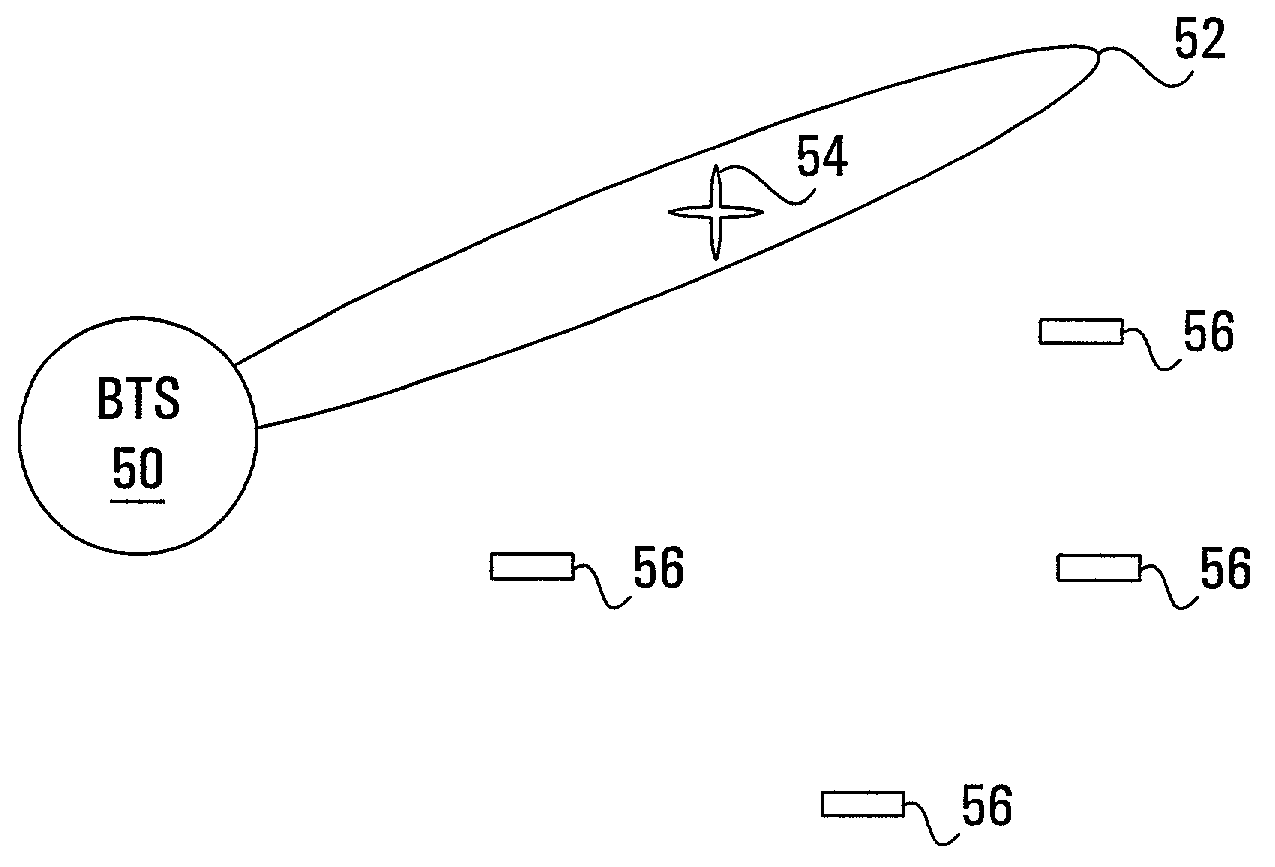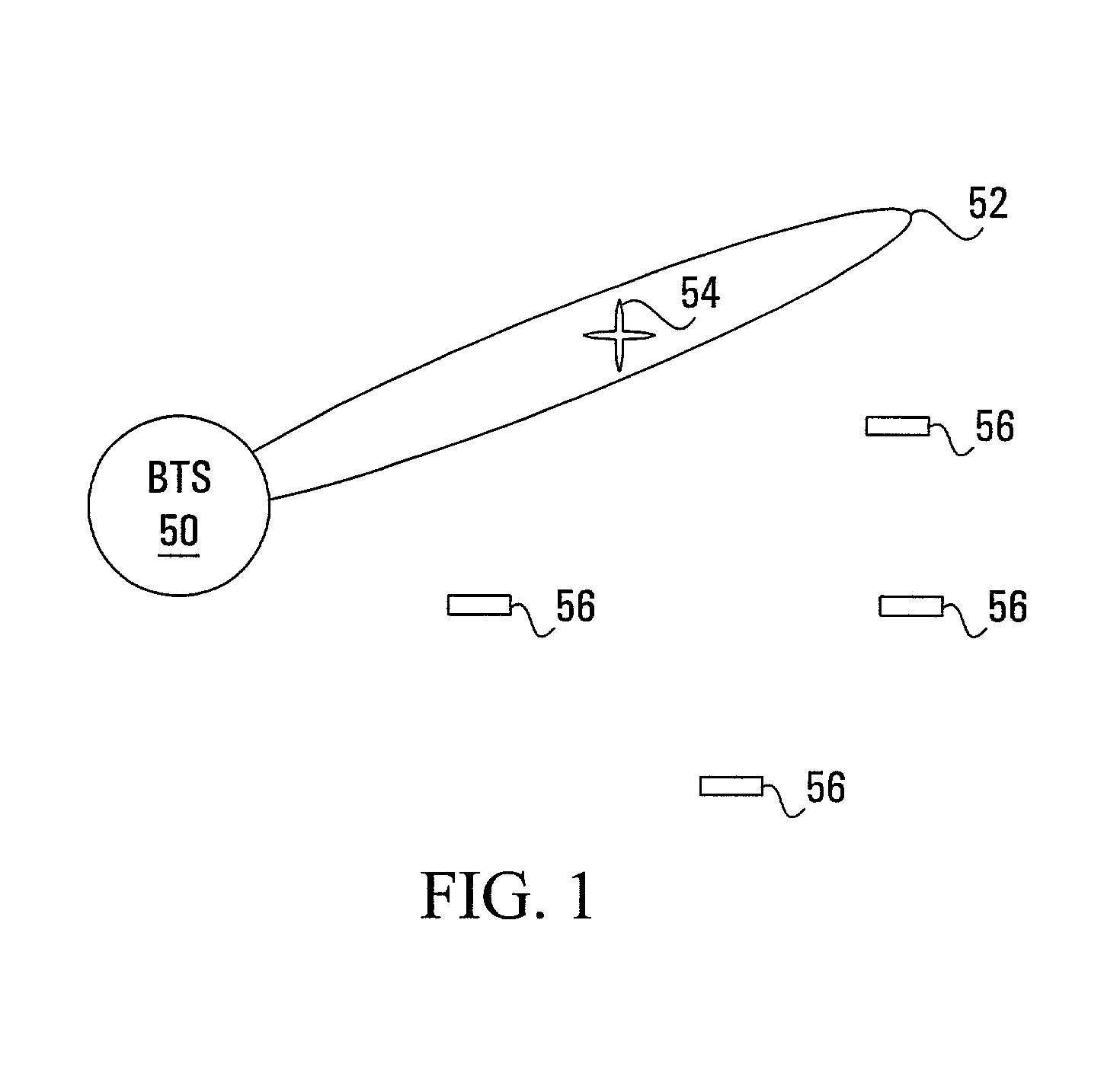Apparatus and method for OFDM data communications
a technology of data communication and apparatus, applied in the field of radio data communication, can solve the problems of increasing interference, limited power (or link gain) of sector omni-directional broadcast, and increasing the cost of power to transmit the rf channel to the target mobile terminal(s) with sector omni-directional broadcast,
- Summary
- Abstract
- Description
- Claims
- Application Information
AI Technical Summary
Benefits of technology
Problems solved by technology
Method used
Image
Examples
first embodiment
[0033]In the present invention, as illustrated in FIG. 1, a BTS 50 utilizes a directional wireless beam 52 to transmit data traffic channels to a target mobile terminal 54. Data traffic information (within the data traffic channels), as stated above, may include pilot signal information which may be used for channel estimation. The use of a directional beam system allows sufficient link gain to transmit the data traffic channels within the RF channel to the target mobile terminal 54 by steering energy towards the terminal 54 and thus, improving radio link performance. The use of this directional wireless beam achieves the needed power gain to the target mobile terminal 54 as well as reducing interference due to reuse of the same RF channel in neighbouring cells (or even within the same cell). Directing the energy in this way results in other mobile terminals 56 outside of the beam 52 to receive no or very limited amounts of the transmitted signals within the RF channel. Thus, the mo...
second embodiment
[0053]FIG. 5 is a block diagram illustrating a radio system using OFDM, according to the present invention, similar to that depicted in FIG. 1 but with the BTS 50 having a directional transmission beam for the data channels, hereinafter referred to as a data traffic directional beam, and a separate sector omni-directional transmission beam for the pilot and signalling channels, hereinafter referred to as a service sector omni-directional beam. Within FIG. 5, a directional beam 88 is utilized as the data traffic beam in order for the BTS 50 to transmit the data traffic with sufficient link gain to the target mobile terminal 54 while a sector omni-directional beam 89 is utilized as the service beam in order for the BTS 50 to transmit the pilot and signalling channels continually to all of the mobile terminals in its coverage area. A sector omni-directional beam is generally sufficient for transmission of the pilot and signalling channels to the mobile terminals since the bit rate of t...
third embodiment
[0067]FIG. 7 is a block diagram illustrating a radio system using OFDM, according to the present invention, similar to that depicted in FIG. 5 but with the BTS 50 having a data traffic directional beam 118 and a separate service directional beam 119. Within FIG. 7, the data traffic directional beam 118 allows the BTS 50 to transmit the data traffic with sufficient link gain to the target mobile terminal 54 similar to that described for FIG. 6A while the service directional beam 119 allows the BTS 50 to transmit the pilot and signalling channels to all of the mobile terminals in its coverage area. This alternative is particularly advantageous in cases where the link gain of a sector omni-directional beam is not sufficient for transmission of the pilot and / or signalling channels to the mobile terminals. The directional service beam can be swept about the coverage area to reach all of the mobile terminals in time. Additionally, a plurality of service beams 118 could be used to reach a ...
PUM
 Login to View More
Login to View More Abstract
Description
Claims
Application Information
 Login to View More
Login to View More - R&D
- Intellectual Property
- Life Sciences
- Materials
- Tech Scout
- Unparalleled Data Quality
- Higher Quality Content
- 60% Fewer Hallucinations
Browse by: Latest US Patents, China's latest patents, Technical Efficacy Thesaurus, Application Domain, Technology Topic, Popular Technical Reports.
© 2025 PatSnap. All rights reserved.Legal|Privacy policy|Modern Slavery Act Transparency Statement|Sitemap|About US| Contact US: help@patsnap.com



